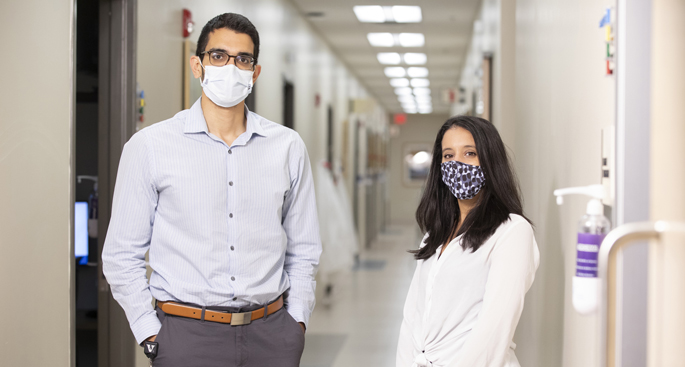
by Emily Stembridge
Osama El Shamy, MD, assistant professor of Medicine in the Division of Nephrology and Hypertension, has long been a proponent of the benefits of home dialysis. After completing a year as the inaugural at-home dialysis fellow for the Icahn School of Medicine at Mount Sinai, he came to VUMC in September 2020. At the time, he had no idea that a global pandemic would soon commence, making the Home Dialysis Program more necessary than ever before.
Home dialysis allows patients to complete peritoneal dialysis or hemodialysis in the comfort of their own homes rather than in a dialysis clinic. Home dialysis options are vital to improving quality of life and comfort for patients.
While in-center dialysis allows patients to be fully taken care of by doctors and nursing staff, making the experience relatively easy for the patient, El Shamy believes that many people benefit from the opportunity to play a more hands-on role in their care.
“At-home dialysis allows patients to be active members of their care team,” El Shamy said. “That empowers our patients. It’s important both mentally and physically to feel in control of your care.”
Patients utilizing home dialysis undergo rigorous training with a nurse for one to six weeks followed by a home visit to assess the adequacy of the patients’ environment and a psychosocial evaluation to ensure they are able to lead their own kidney care. After these steps are complete, patients can begin home dialysis.
“Patients often tell me that doing dialysis at home is easier than they expected it to be,” El Shamy said. “Everyone has a daunting idea of what dialysis is, but patients overcome those fears when they see it themselves firsthand.”
The Division of Nephrology and Hypertension has long been at the leading edge of home dialysis therapy, with approximately 40% of VUMC patients with end-stage kidney disease pursuing home therapies. The national average for home dialysis is 12%.
“With the renewed national focus on increasing the number of patients treated using home modalities and the recent Presidential Executive Order, we have proven a model for patient choice,” said Megha Salani, MD, medical director of the Home Dialysis Program and assistant professor of Medicine in the Division of Nephrology and Hypertension. “Over 65% of patients starting dialysis at Vanderbilt have started on home therapies over the past five years, an unprecedented rate for any clinical nephrology practice in the United States.”
When the COVID-19 pandemic began, options for at-home care and telehealth became even more vital. Rather than spending hours in a dialysis clinic, patients had the option to do dialysis at home and minimize the risk of contracting or spreading COVID-19.
“During the pandemic, we started offering telehealth for our patients’ once-monthly check-in visits,” El Shamy said. “We deliver their supplies and medications to their homes, decreasing the risk of getting COVID-19 compared to in-center dialysis.”
Other benefits of home dialysis include more flexibility with the timing of dialysis, not needing to arrange transportation to and from the dialysis center and a level of comfort for patients who may feel anxious in a medical setting.
Salani and El Shamy are now working to develop a dialysis fellowship for Vanderbilt University School of Medicine, including a focus on both home and in-center dialysis.
“Our goal is to become a Center of Excellence for dialytic therapies and management of patients with kidney failure and an example for other health care systems across the country,” said T. Alp Ikizler, MD, Catherine McLaughlin Hakim Professor of Vascular Biology, professor of Medicine and director of the Division of Nephrology and Hypertension. “We are already one of the best and want to be as ahead of the curve as we can be at Vanderbilt.”












